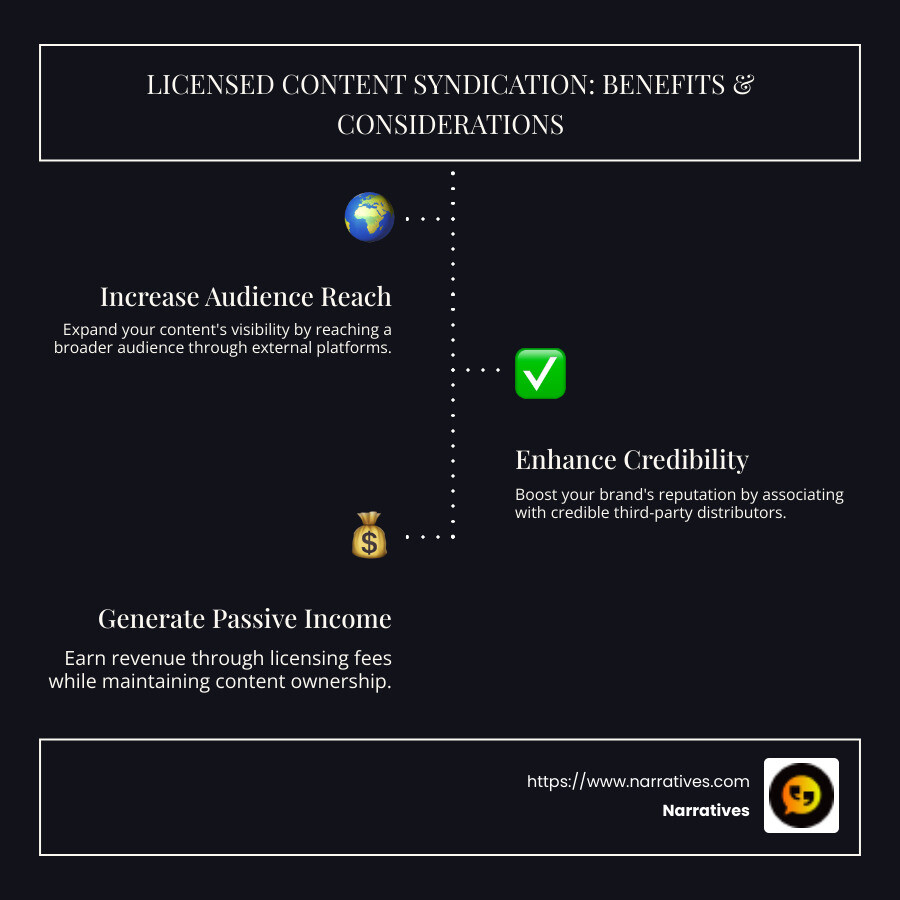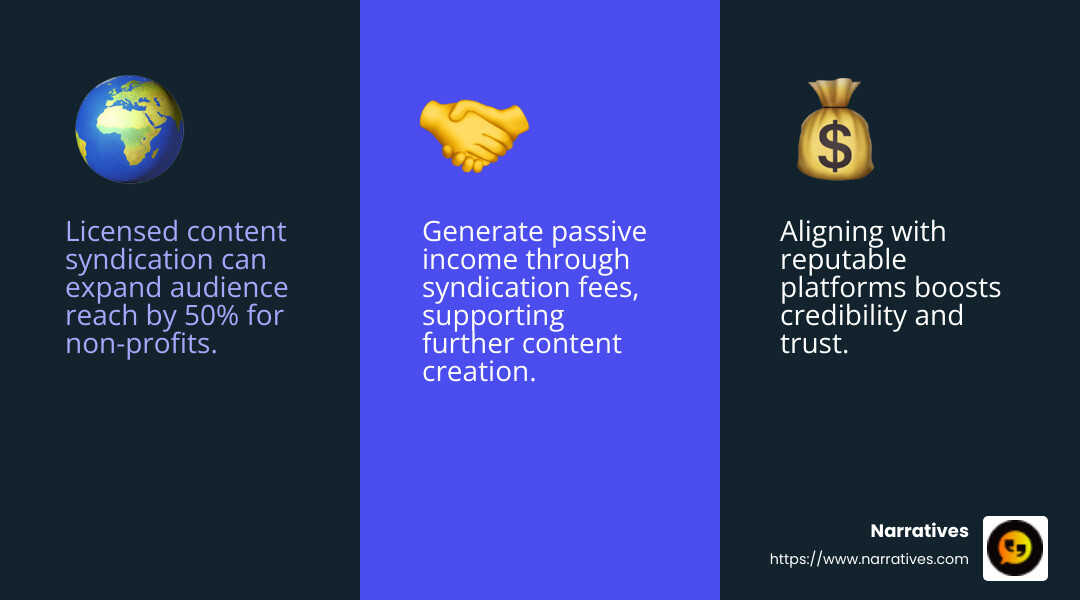The Ins and Outs of Licensed Content Syndication

Licensed content syndication is a powerful tool for non-profits and advocacy-focused brands aiming to broaden their message and impact. By allowing third-party platforms to share your digital content, you can improve your storytelling reach without relinquishing ownership. This strategy amplifies your mission and ensures your message resonates with a wider audience.
What is licensed content syndication?
- A partnership where your content is shared through external distributors while you retain ownership.
Key Benefits:
- Increases audience reach.
- Improves credibility.
- Generates passive income.
Considerations:
- Control over where and how your content is shared.
- Understanding non-exclusivity and ownership rights.
Licensed content syndication allows mission-driven organizations to share their narratives effectively, leveraging stories that matter. It bridges the gap between content creation and audience engagement, vital for non-profits seeking to empower communities and drive meaningful social change.

Understanding Licensed Content Syndication
When it comes to licensed content syndication, understanding its core components is crucial for leveraging its full potential. This model involves distributing your content through external platforms while maintaining ownership. Let's break down the key benefits and consider the challenges involved.
Key Benefits
Audience Reach: Licensed content syndication can significantly expand your audience. By distributing your content across various platforms, you expose your message to new and diverse groups. For non-profits, this means reaching individuals who might not have encountered your mission otherwise.
Credibility: Associating your content with reputable platforms improves your organization's credibility. When well-known distributors share your content, it signals to audiences that your message is valuable and trustworthy.
Passive Income: Syndication can generate passive income. Distributors often pay a fee to access and share your content, providing a financial incentive alongside the exposure benefits. This revenue can support further content creation and other organizational activities.

Challenges and Considerations
Ownership Rights: While you retain ownership of your content, understand the specifics of your licensing agreement. Ensure that your rights are protected and that you have control over how your content is used.
Non-Exclusivity: Many syndication agreements are non-exclusive, meaning your content can be shared by multiple distributors. While this increases reach, it may also require careful management to maintain brand consistency and message integrity.
Content Control: One of the main challenges is maintaining control over how and where your content is shared. It's vital to work with distributors who respect your content guidelines and align with your mission.
Licensed content syndication is a strategic approach that empowers organizations to amplify their impact. By carefully navigating the benefits and challenges, you can ensure your content not only reaches a wider audience but also aligns with your goals and values.
Types of Content Syndication
Content syndication comes in various forms, each with its unique advantages and challenges. Let's explore the three main types: licensed content syndication, ad-supported syndication, and free or bartered syndication.
Licensed Content Syndication
Licensed content syndication involves a formal agreement where content creators license their work to distributors for a fee. This model is ideal for those who want to maintain ownership and control over their content while reaching a broader audience.
Copyright: As a content creator, you retain the copyright. This means you have legal protection and control over how your content is used. It's crucial to understand your licensing agreement to ensure your rights are safeguarded.
Fee Structure: Distributors pay a fee to use your content. This could be a flat fee, a share of revenue, or a combination of both. This financial arrangement not only compensates you for your work but also incentivizes quality content creation.
Content Partnerships: Collaborating with reputable distributors can improve your credibility. These partnerships can help your content reach new audiences and build trust in your brand.
Ad-Supported Content Syndication
In this model, content is distributed through platforms that generate revenue via advertisements. It's a popular choice for those looking to monetize their content without directly charging distributors.
Ad Revenue: Platforms earn money from ads displayed alongside your content. You may receive a portion of this revenue, depending on your agreement.
Impression-Based: Revenue can be based on the number of impressions your content receives. More views mean more earnings, making it essential to create engaging content that attracts attention.
Pay-Per-Click: Some agreements may include pay-per-click (PPC) models, where revenue is generated each time an ad is clicked. This can be lucrative if your content drives high engagement.
Free or Bartered Content Syndication
Free or bartered syndication involves distributing content without direct financial compensation. Instead, the focus is on expanding reach and gaining exposure.
Exposure: This model is excellent for building brand awareness. By offering your content for free, you can reach audiences that might be inaccessible through other means.
Audience Expansion: Syndicating content for free can introduce your work to new demographics, expanding your audience base.
Content Aggregators: Platforms that aggregate content from various sources can help distribute your work widely. While you may not earn money directly, the increased visibility can lead to new opportunities.
Each syndication model has its benefits and considerations. Choosing the right one depends on your goals, resources, and the level of control you wish to maintain over your content.
Strategies for Effective Content Syndication
Navigating licensed content syndication can seem daunting, but with the right strategies, you can maximize your content's reach and impact. Let's explore custom approaches for different content creators: avid amateurs, established voices, and seasoned professionals.
For Avid Amateurs
Avid amateurs, like Bruce the crypto blogger, can leverage social media to extend their reach. Targeted sharing is key. Instead of blasting content everywhere, focus on platforms where your target audience hangs out. Bruce, for example, chooses LinkedIn and X to connect with young tech enthusiasts.
Goal Setting: Define what you want to achieve. Is it more followers, increased engagement, or something else? Clear goals guide your strategy.
Audience Targeting: Know your audience. Use analytics to understand who they are and what they like. This helps in crafting messages that resonate.
Content Quality: High-quality content attracts attention. Ensure your posts are informative, engaging, and relevant.
For Established Voices
Established voices can benefit from platform partnerships and building brand recognition. Collaborating with industry publications can position you as a thought leader.
Platform Partnerships: Work with platforms that align with your brand. This can improve your credibility and widen your audience.
Brand Recognition: Consistency is key. Ensure your content aligns with your brand's voice and values. This builds trust and recognition.
Industry Publications: Publish in reputable industry outlets. This not only boosts your profile but also connects you with peers and potential collaborators.
For Seasoned Professionals
Seasoned professionals should consider comprehensive syndication strategies to maintain their influence and expand their reach.
Professional Audiences: Tailor your content to professional networks. Engage with platforms that cater to your industry and expertise.
Expert Networks: Join expert forums and groups. Sharing insights and participating in discussions can improve your visibility and authority.
Comprehensive Syndication: Use a mix of syndication models. Balance between licensed, ad-supported, and free syndication to maximize reach while maintaining control.
By adopting these strategies, content creators at every level can effectively leverage licensed content syndication to achieve their goals and expand their influence.
Frequently Asked Questions about Licensed Content Syndication
What is licensed content syndication?
Licensed content syndication is a process where content creators allow their work to be distributed by third-party distributors in exchange for a fee. This model lets publishers retain ownership of their content while granting specific usage rights to others. Think of it as renting out your content. You keep the rights, but others get to share it with their audience.
Licensed syndication can expand your content's reach significantly. By working with distributors, your work can appear in various prestigious platforms, from academic libraries to media organizations. This is a fantastic way to get your content in front of new audiences without losing control of your original material.
How does licensed content syndication benefit publishers?
Licensed content syndication offers several key benefits for publishers:
Wider Audience Reach: By partnering with distributors, your content can reach audiences you might not access on your own. This includes professional sectors like finance, law, and academia.
Credibility and Authority: Being featured on well-known platforms improves your credibility. It's like getting a stamp of approval from respected industry players.
Passive Income: Publishers earn a portion of the fees distributors pay to access their content. This means you can earn money while focusing on creating more great content.
Take, for example, a content creator who partners with a distributor that manages the contracts and payments, allowing the creator to focus on what they do best—producing high-quality content.
What should publishers consider before syndicating content?
Before diving into licensed content syndication, consider these important factors:
Ownership Rights: Always ensure you retain ownership of your content. This means you can continue to use and distribute it as you see fit.
Non-Exclusivity: Decide whether to grant exclusive or non-exclusive rights. Non-exclusive rights let you syndicate content to multiple distributors, which can broaden your reach.
Content Control: Understand how your content will be used and where it will appear. This helps maintain your brand's integrity and ensures your content aligns with your goals.
For instance, if you have a niche blog on environmental sustainability, you might want to ensure your content appears on platforms that share similar values. This way, you maintain your brand's message and reach the right audience.
By considering these aspects, publishers can make informed decisions about their syndication strategy, maximizing benefits while maintaining control over their content.
Conclusion
In the field of licensed content syndication, Narratives stands out as a dedicated partner for non-profits and purpose-driven organizations. Our mission is to lift underrepresented voices through impactful digital storytelling, empowering organizations to share their stories in ways that inspire action and foster trust.
Narratives and Non-Profit Partnerships
At Narratives, we recognize the power of storytelling in driving change. By partnering with non-profits, we help shine a light on their incredible work and the communities they serve. Our focus is on creating high-quality, emotionally resonant content that captures the essence of each organization's mission. This approach not only improves visibility but also builds a deeper connection with audiences.
Social Impact Storytelling
Social impact storytelling is at the heart of what we do. We believe that stories have the power to transform perceptions and mobilize support for important causes. Through licensed content syndication, we ensure these stories reach wider audiences, maximizing their impact. By aligning with platforms that share our values, we maintain the integrity of the message while expanding its reach.
In conclusion, licensed content syndication offers a unique opportunity for non-profits to amplify their voices and drive meaningful change. At Narratives, we are committed to supporting these efforts through strategic partnerships and innovative storytelling.
Learn more about how we can help your organization tell its story and make a difference in the world by visiting our service page.


